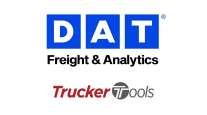Staff Reporter
Spot Rates for Vans, Reefers Slip in April

April saw strong volumes and abundant capacity in spot market truckload freight, according to DAT Solutions’ monthly report.
Volumes for dry van freight — the most common semi-trailer type — increased 2.4% in April compared with a year earlier, according to DAT, which operates the largest truckload freight marketplace in North America.
But despite sustained volume, the national average spot van rate fell 35 cents per mile year over year due to readily available truckload capacity.
Nationally, load-to-truck ratios declined, but demand heated up in parts of the Southeast, in California, and in key markets along the border with Mexico. https://t.co/kIzisalME5
— DAT Solutions (@LoadBoards) May 14, 2019
“Spring came late to the spot market this year,” DAT senior industry analyst Mark Montague said in the May 13 report. “Late-season snowstorms in Minnesota and Colorado, as well as flood-related damage in and around Nebraska, led to delays in truck and rail traffic.”
Some spot market service providers are growing rapidly this year, and that growth offsets losses in other sectors, according to DAT.
Month-over-month trends followed a familiar seasonal pattern: DAT reported its Truckload Freight Volume Index declined 5% for van freight in April compared with March, and the national average spot rate of $1.81 per mile was 4 cents lower. These seasonal declines mirror three of the past five years, DAT officials reported.
Contributing to the decline was a delay in spring produce, which affected refrigerated equipment, DAT reported. Refrigerated volumes were down 11% in April compared with March.
It is not a typical seasonal trend for April, and the volume shortfall was accompanied by a 2-cent drop in the average spot rate for reefer freight, to $2.15 per mile. On a year-over-year basis, reefer volume slipped 2.9%, and the national average rate dropped 28 cents per mile, DAT reported.
Flatbed load volume remained strong in April, DAT said, losing only 0.9% as rates edged down by 1 cent compared with March, to $2.33 per mile. Year over year, flatbeds hauled 9.1% more loads for 31 cents less per mile.
“Overall freight availability remained high in April compared to recent years, despite the small seasonal decline,” Montague said in the report. “As we head into peak season for spot market freight, we expect regional capacity shortages to emerge and boost rates higher through the end of the second quarter.”
But another major freight analyst said April’s numbers are cause for concern. On March 15, Cass Informations Systems Inc. issued its monthly freight report, stating North American freight volumes declined in April, year over year, for the fifth straight month, signaling “a possible economic contraction.”
The report’s author, Donald Broughton, wrote that U.S.-China trade disputes and an economic softening are likely real issues, despite the report of strong economic growth in the first three months of 2019.
Reefer market update: While several markets experienced price increases, it wasn't enough to boost the national average reefer rate. https://t.co/lJvEXUxvUA — DAT Solutions (@LoadBoards) May 15, 2019
April freight movement was down 3.2% from a year before, Cass reported.
“With April down 3.2%, we see material and growing downside risk to the economic outlook,” the report says. “The initial first quarter of 2019 gross domestic product report of 3.2% suggests the economy is growing faster than is reflected in the Cass Shipments Index. … The weakness in spot market pricing for many transportation services, especially trucking, is consistent with the negative Cass Shipments Index and, along with airfreight and railroad volume data, heightens our concerns about the economy and the risk of ongoing trade policy disputes.”
The DAT Truckload Freight Volume Index is based on load counts and per-mile rates recorded in DAT RateView, with an average of 3 million freight moves per month, according to DAT Solutions. Spot market information is based on transactions arranged by third-party logistics companies, while contract volumes and rates are arranged between shippers and carriers, with no intermediary.
Founded in 1978, DAT Solutions is a subsidiary of Roper Technologies.




